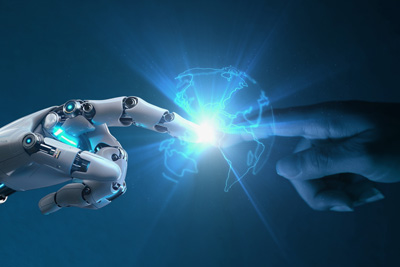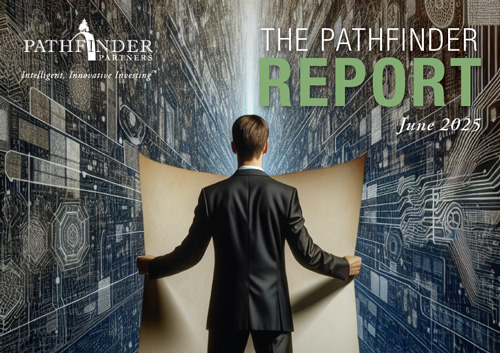Charting the Course
How the AI Tsunami Will Reshape Our World in Short Order
By Mitch Siegler, Senior Managing Director

We stand at the cusp of another seismic technological shift – maybe the most transformative in human history. While the wheel, printing press, internal combustion engine, telephone and airplane changed the course of history, modern technological innovations – the internet, smartphones, and cloud computing – have had similarly meaningful and faster impacts on our way of life.
Looking ahead, the prospect of artificial intelligence (AI) disrupting and redefining our lives is mind-boggling; the impact of all that’s come before could pale in comparison to what AI leaves in its wake. In a few short years, AI will fundamentally alter our business, personal and geopolitical landscapes.
And in case you think this is a 2001: A Space Odyssey kind of thing – think again. It’s happening today and the wave has been building for several years already!
The Productivity Revolution
AI is destined to turbocharge productivity in extraordinary ways. Already, we’re hearing experts predict that the adoption of AI will decimate entry-level and mid-level management ranks and could lead to tens of millions of jobs lost by 2030. The impact on the labor force could make the outsourcing of our factories and the loss of blue-collar jobs to Asia, Mexico and elsewhere in the past few decades seem like the warm-up act.
During the past few decades, entire service industries were revolutionized as knowledge-based workflow shifted from higher-cost areas like North America and Europe to lower-cost areas in Asia and Eastern Europe. This outsourcing of accounting and tax preparation, architecture and design, medical records and radiology work has boosted productivity, mostly due to labor cost savings and faster turnaround time (as work was completed in these outsourced countries at night and then reviewed for accuracy and edited the next morning in the outsourcing country). This shift in workflow was first-level stuff compared with what we’ll see with AI.
The foundational elements of AI – Large Language Models (LLMs) like GPT, Perplexity and Claude – are already revolutionizing many white-collar jobs. During the next few years, these models will move from productivity enhancers to robotic “co-workers”, reshaping and upending a wide array of jobs.
 Rote and repetitive work – customer support, tax return preparation, drafting emails, analyzing legal documents, coding and spreadsheet/financial model preparation – are increasingly handled by AI, freeing up staff for higher-value work. Consulting firm McKinsey projects that by 2028, the productivity impacts of AI could add $4.4 trillion to global gross domestic product (GDP).
Rote and repetitive work – customer support, tax return preparation, drafting emails, analyzing legal documents, coding and spreadsheet/financial model preparation – are increasingly handled by AI, freeing up staff for higher-value work. Consulting firm McKinsey projects that by 2028, the productivity impacts of AI could add $4.4 trillion to global gross domestic product (GDP).
AI will also flatten the competitive playing field for small and mid-sized businesses. The differences in capabilities between small businesses and enterprise companies, once vast, have been shrinking and will continue to shrink rapidly with AI. Now, a startup in a garage can field an AI-powered customer service team, perform analytics approaching the level of a Fortune 100 company and generate code at the scale of a several-hundred-person software company. AI could make the adage “size isn’t everything” a reality in business. Competitive advantages will increasingly depend on proprietary data, a culture of innovation, and speed of execution – no longer just size, scale and financial resources.
Labor Market Upheaval
For every action, there’s an equal and opposite reaction – all technological advances generate consequences. While AI enhances many roles, it also automates others – and job losses are inevitable. The World Economic Forum’s 2024 Future of Jobs Report forecasts that AI and automation will disrupt 44% of workers’ core skills – by 2028!
Most at risk are the rote, repetitive functions common in customer service, data entry and administrative support; even creative jobs like copywriting and graphic design are at risk. In parallel, we’ll see large increases in demand for AI professionals – entire new industries will spring up and competition will be heated for jobs we’ve never heard of, like prompt engineers, AI ethicists and hybrid creatives who can blend human insight with machine intelligence. The mind boggles.
As with previous disruptive technologies, we’ll need fewer people for the same tasks – but we’ll need more people to oversee, integrate, and manage AI systems. We’ll need our governments, businesses and educators to act urgently and thoughtfully to encourage worker retraining. While AI won’t replace human work, those adept at using AI will likely displace those who aren’t.
A Game-Changer for Investors
When I learned about investing – in the ‘80s when dinosaurs roamed the earth – prospective investments were gleaned from a universe of thousands of candidates and even preliminary financial screens took hours. Overlaying financial forecasts, assessing analyst price targets and comparing financial performance to that of comparable companies added much more time. And that was to conduct preliminary analysis on a single potential investment candidate. Today, an individual investor with a smartphone can generate an amalgamation of historical and projected financial results, Wall Street analyst ratings and peer group analysis on a company, group of companies or industry sector in seconds.
The venture capital environment has similarly changed. While VC’s and private equity firms still evaluate scores of prospective new investment candidates to make one investment, the barriers to entry for new companies are much lower today. As productivity enhancing software has eaten so many traditional industries, a couple of smart people with a new idea or a twist on an old one can quickly build and scale a company – often with far less capital than was needed five years ago. AI will accelerate those trends.
The old ways of assessing real estate acquisitions were even more time-consuming than evaluating equity investments since the level of publicly available information on typical properties paled in comparison to what could be found for publicly traded companies. While the internet and company/property databases have made these screens and analyses much more productive, we are in the early innings of what will ultimately be possible with AI.
Virtual tours on our property websites, and 24/7 call centers staffed by customer service bots which can provide timely information on unit availability, property features and costs are already here. We are testing A.I. programs that detect fraudulent tenant bank statements, help collect past-due rent and aggregate public information on competitor pricing.
In property operations, Pathfinder is using an AI-enabled, live-monitored, security camera system designed to prevent crimes before they happen and software which screens prospective tenants based not only their credit scores, payment default histories and track record of paying previous landlords but also on intangibles that help guide decision-making about a tenant’s likelihood of paying rent in a timely fashion.
AI in the Boardroom
Companies are already grappling with AI’s strategic implications. Boards are forming AI oversight committees. CEOs are investing heavily in AI. Chief Information Officers, who barely existed a decade ago, now have extraordinary authority and work closely with Human Resources departments to map out the future of work.
Soon, we’ll see AI play a direct role in high-level decision making. Predictive models will shape product and brand strategy, supply chain management, geographic expansions, logistics, pricing algorithms, and merger and acquisition analysis. Companies will move faster and those who use AI effectively could make better decisions with fewer major errors.
The Dawn of a New Era in Medical Care
 AI will contribute to solutions for many of our most pressing challenges – like an aging population. AI can potentially transform our healthcare system, driving down costs and extending lifespans and quality of life. Personalized medicine – where treatments are tailored to a patient’s genetic and lifestyle data – will be accelerated with AI. Today, AI models are diagnosing conditions like cancer with accuracy rivaling or exceeding top physicians. Very soon, expect more AI-driven diagnostics, treatment recommendations, and drug development.
AI will contribute to solutions for many of our most pressing challenges – like an aging population. AI can potentially transform our healthcare system, driving down costs and extending lifespans and quality of life. Personalized medicine – where treatments are tailored to a patient’s genetic and lifestyle data – will be accelerated with AI. Today, AI models are diagnosing conditions like cancer with accuracy rivaling or exceeding top physicians. Very soon, expect more AI-driven diagnostics, treatment recommendations, and drug development.
Pharmaceutical companies are leveraging AI to accelerate drug discovery cycles dramatically. Life sciences labs can screen thousands of drug candidates in less time than they previously took to evaluate one. In rural and underserved urban areas where doctors are scarce, AI-powered tools can bridge gaps by supplementing diagnostic and treatment options. AI could make telemedicine far more commonplace.
Questions like how to ensure data privacy, the role of the FDA, appropriate insurance reimbursements and the implications of AI on medical ethics are just a few things we’ll be grappling with soon.
Geopolitical Implications
The Ukrainians are showing the world the future of warfare – with autonomous drones swarming far away targets in the dark of night.
As global and regional powers chart their futures, they see AI not just as an economic tool but as a strategic priority. The U.S., China and the EU are racing to establish AI supremacy. Russia, Japan, Taiwan, Turkey and Iran are leveraging their strong military and cybersecurity foundations in the race for AI supremacy. AI will be key to the future of military logistics, surveillance and autonomous weapons systems. Ethical questions around the use of AI in warfare are no longer theoretical – they’re essential policy and diplomacy considerations.
Without cooperation, like what we’ve had in nuclear nonproliferation, AI’s weaponization could escalate rapidly, especially with generative AI tools which can produce and spread misinformation and deepfakes. Threats from foreign powers on election integrity, already a major concern, is likely to grow with AI.
Our Advice: Embrace and Adapt but Don’t Fear
The AI revolution is not something off on the horizon – it’s today’s headlines. The next few years could determine whether AI becomes a powerful tool to aid humanity or a destabilizing force.
For investors, there are a world of possibilities: investing in AI infrastructure and chips, identifying new vertical applications in healthcare or education, screening potential real estate investments and much more. An investor can probably be successful merely by identifying those companies and investors who will more effectively utilize AI than their competitors – identifying winners who will better adapt or losers who will decline or die.
For workers, adapting and upskilling are critical. Be the one in your department or on your team who leads the charge on AI initiatives. Don’t be the laggard.
For elected officials and policymakers, it will be essential to balance the pace of innovation with responsible standards. We will not be well served by politicians who kick the can on sensible guardrails and policies.
But the ultimate success of the AI transition probably won’t be measured by GDP growth, investment gains or stock market performance alone. It will hinge on our collective ability to harness AI’s power while preserving our values, humanity and sense of purpose.
We’re on the cusp of major change. The next few years will test not just our technology and ability to adapt – they’ll also test our judgment and wisdom.
Mitch Siegler is Senior Managing Director of Pathfinder Partners. Prior to co-founding Pathfinder in 2006, Mitch founded and served as CEO of several companies and was a partner with an investment banking and venture capital firm. He can be reached at msiegler@pathfinderfunds.com.
Share this Article
IN THIS ISSUE
PATHFINDER MULTIFAMILY OPPORTUNITY FUND IX, L.P.
CHARTING THE COURSE
How the AI Tsunami Will Reshape Our World in Short Order
FINDING YOUR PATH
Hitting The Peak of Apartment Deliveries
GUEST FEATURE
Grading Interest Rate Predictions
ZEITGEIST
News Highlights
TRAILBLAZING
Sundance Apartments, Milton (Seattle), WA
NOTABLES AND QUOTABLES
Innovation
